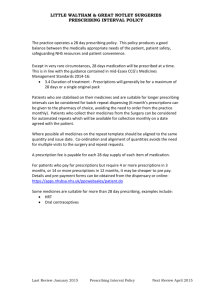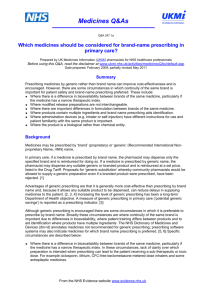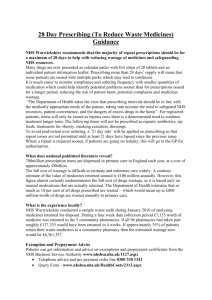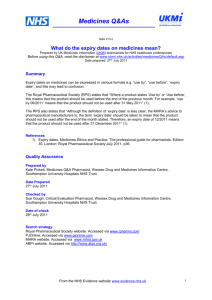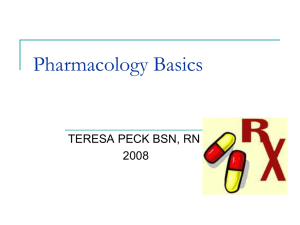Brand-name Prescribing in Primary Care
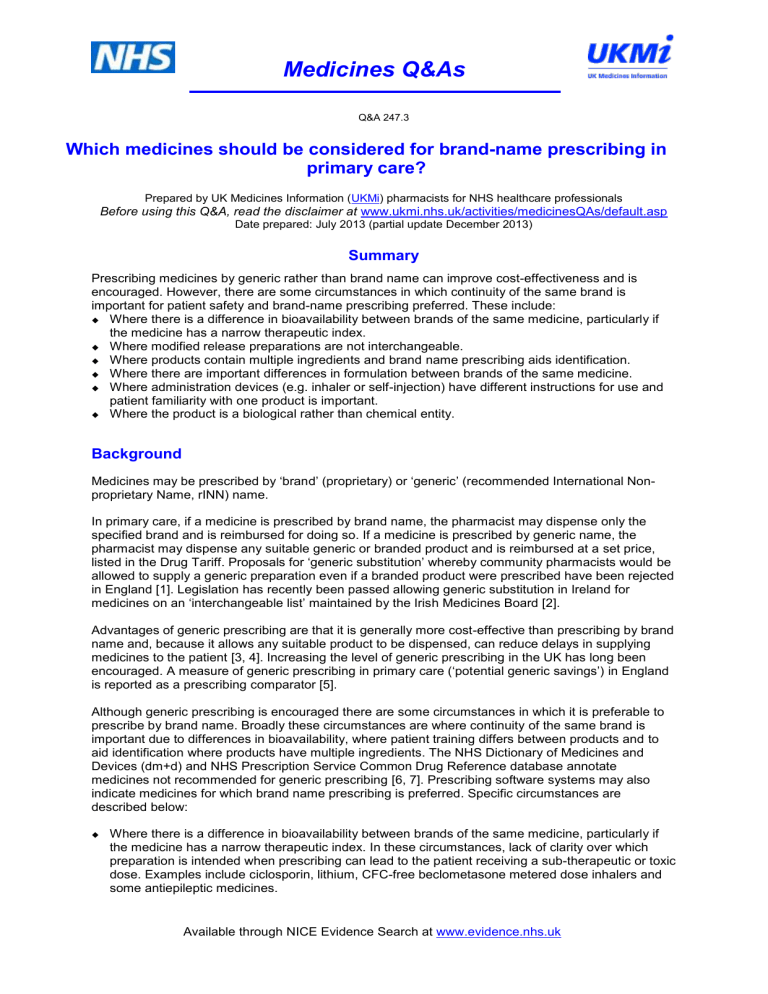
Medicines Q&As
Q&A 247.3
Which medicines should be considered for brand-name prescribing in primary care?
Prepared by UK Medicines Information ( UKMi ) pharmacists for NHS healthcare professionals
Before using this Q&A, read the disclaimer at www.ukmi.nhs.uk/activities/medicinesQAs/default.asp
Date prepared: July 2013 (partial update December 2013)
Summary
Prescribing medicines by generic rather than brand name can improve cost-effectiveness and is encouraged. However, there are some circumstances in which continuity of the same brand is important for patient safety and brand-name prescribing preferred. These include:
Where there is a difference in bioavailability between brands of the same medicine, particularly if the medicine has a narrow therapeutic index.
Where modified release preparations are not interchangeable.
Where products contain multiple ingredients and brand name prescribing aids identification.
Where there are important differences in formulation between brands of the same medicine.
Where administration devices (e.g. inhaler or self-injection) have different instructions for use and patient familiarity with one product is important.
Where the product is a biological rather than chemical entity.
Background
Medicines may be prescribed by ‘brand’ (proprietary) or ‘generic’ (recommended International Nonproprietary Name, rINN) name.
In primary care, if a medicine is prescribed by brand name, the pharmacist may dispense only the specified brand and is reimbursed for doing so. If a medicine is prescribed by generic name, the pharmacist may dispense any suitable generic or branded product and is reimbursed at a set price, listed in the Drug Tariff. P roposals for ‘generic substitution’ whereby community pharmacists would be allowed to supply a generic preparation even if a branded product were prescribed have been rejected in England [1]. Legislation has recently been passed allowing generic substitution in Ireland for medicines on an ‘interchangeable list’ maintained by the Irish Medicines Board [2].
Advantages of generic prescribing are that it is generally more cost-effective than prescribing by brand name and, because it allows any suitable product to be dispensed, can reduce delays in supplying medicines to the patient [3, 4]. Increasing the level of generic prescribing in the UK has long been encouraged. A measure of generic prescribing in primary care (‘potential generic savings’) in England is reported as a prescribing comparator [5].
Although generic prescribing is encouraged there are some circumstances in which it is preferable to prescribe by brand name.
Broadly these circumstances are where continuity of the same brand is important due to differences in bioavailability, where patient training differs between products and to aid identification where products have multiple ingredients. The NHS Dictionary of Medicines and
Devices (dm+d) and NHS Prescription Service Common Drug Reference database annotate medicines not recommended for generic prescribing [6, 7]. Prescribing software systems may also indicate medicines for which brand name prescribing is preferred. Specific circumstances are described below:
Where there is a difference in bioavailability between brands of the same medicine, particularly if the medicine has a narrow therapeutic index. In these circumstances, lack of clarity over which preparation is intended when prescribing can lead to the patient receiving a sub-therapeutic or toxic dose. Examples include ciclosporin, lithium, CFC-free beclometasone metered dose inhalers and some antiepileptic medicines.
Available through NICE Evidence Search at www.evidence.nhs.uk
Where modified release preparations are not interchangeable, particularly if the medicine has a narrow therapeutic index. This avoids confusion between formulations with different release characteristics. Examples include aminophylline, diltiazem and morphine.
Where there are important differences in formulation between brands of the same medicine. For example, fentanyl patches are available as matrix formulations and reservoir formulations.
Reservoir patches must not be cut because damage to the rate-limiting membrane can lead to a rapid release of fentanyl resulting in overdose. If the prescriber intends the patch to be cut
(although this is unlicensed and not recommended by the MHRA) then the prescription must specify a brand of matrix formulation patch.
Where products contain more than one ingredient and brand name prescribing aids identification.
This is useful when prescribing products with multiple ingredients (e.g. pancreatin supplements, skin and scalp preparations) and to differentiate between similar products where patient familiarity with a brand is important (e.g. hormone replacement therapy and oral contraceptives).
Where administration devices have different instructions for use and patient familiarity with one product is important. For example salbutamol dry powder inhalers and adrenaline pre-filled syringes.
Where the product is a biological rather than chemical entity. Such agents are licensed as
‘biosimilar’ medicines. Examples include erythropoietin and somatropin (growth hormone) preparations.
Answer
The following table lists medicines that might be considered for brand-name prescribing. This table has been compiled using a number of sources. Specific references for individual medicines are included where appropriate.
BNF Drug or drug class Reason for considering brand-name prescribing
Specific references
Chapter 1
1.1.1
1.1.2
1.5.1
1.6.1
1.6.4
1.7.2
1.9.4
Antacids preparations containing simeticone
Compound alginates and proprietary indigestion preparations
Mesalazine oral preparations
Bulk forming laxatives
Macrogols (polyethylene glycols)
Compound haemorrhoid preparations
Pancreatin supplements
To aid identification. Products contain multiple ingredients.
To aid identification. Products contain multiple ingredients.
The delivery characteristics of oral mesalazine preparations may vary and should not be considered interchangeable.
To aid identification. Products contain multiple ingredients.
To aid identification. Products contain multiple ingredients.
To aid identification. Products contain multiple ingredients.
To aid identification. Products contain multiple ingredients.
BNF
BNF
BNF
-
-
-
-
Chapter 2
2.6.2 Diltiazem modified release (MR) preparations
MR preparations have different release characteristics and are not interchangeable.
BNF dm+d
Available through NICE Evidence Search at www.evidence.nhs.uk
BNF
2.6.2
Drug or drug class
Nifedipine modified release preparations
Reason for considering brand-name prescribing
MR preparations have different release characteristics and are not interchangeable.
Chapter 3
3.1.1
3.1.1
3.1.3
3.2
3.2
3.2
Formoterol dry powder inhalers
Salbutamol dry powder inhalers
3.1.3 Theophylline modified release preparations
Aminophylline modified release preparations
Beclometasone dipropionate CFCfree pressurised metered dose inhalers
Patient familiarity with one brand is important; instructions for use vary between preparations.
Patient familiarity with one brand is important; instructions for use vary between preparations.
MR preparations have different release characteristics and are not interchangeable. Theophylline has a narrow therapeutic index.
MR preparations have different release characteristics and are not interchangeable. Aminophyline has a narrow therapeutic index.
Qvar and Clenil Modulite are not interchangeable. Qvar has extra-fine particles and is approximately twice as potent as Clenil Modulite and CFCcontaining beclometasone inhalers. The
MHRA has advised that CFC-free beclometasone inhalers should be prescribed by brand name. This applies also to combination products.
Beclometasone dry powder inhalers Patient familiarity with one brand is important; instructions for use vary between preparations.
Beclometasone and formoterol
CFC-free metered dose inhalers
See beclometasone CFC-free metered dose inhalers, above.
3.2
3.4.3
Budesonide dry powder inhalers
Adrenaline (epinephrine) pre-filled syringes
Patient familiarity with one brand is important; instructions for use vary between preparations.
Patient familiarity with one brand is important; instructions for use vary between preparations.
Chapter 4
4.2.3 Lithium preparations
4.4 Methylphenidate modified release preparations
Preparations vary widely in bioavailability.
Changing the preparation requires the same precautions as initiation of treatment. Lithium has a narrow therapeutic index.
MR preparations contain different proportions of immediate-release and modified-release methylphenidate.
Specific references
BNF dm+d dm+d dm+d
BNF
BNF dm+d
BNF dm+d
MHRA [8] dm+d
BNF
MHRA [8]
-
BNF dm+d
BNF dm+d
BNF dm+d
Available through NICE Evidence Search at www.evidence.nhs.uk
BNF
4.7.2
4.7.2
4.7.4
4.8.1
Drug or drug class
Morphine oral modified release preparations
Fentanyl patches
Botulinum toxin type A
Antiepileptic drugs
Reason for considering brand-name prescribing
MR preparations have different release characteristics; Patient familiarity with one brand is important.
Patches are available as matrix and reservoir formulations; Patient familiarity with one brand is important. Reservoir patches must not be cut because damage to the rate-limiting membrane can lead to a rapid release of fentanyl resulting in overdose. If the prescriber intends the patch to be cut (NB: unlicensed and not recommended by the MHRA) then the prescription must specify a brand of matrix formulation patch.
Preparations are not interchangeable due to differences in potency.
Specific references
PCF4 [9]
PCF4 [9]
The MHRA has classified antiepileptic drugs (AEDs) into three categories of risk, based primarily on their therapeutic index and physiochemical characteristics (in particular solubility and permeability across membranes) indicative of potential differences between formulations.
Category 1:
Specific measures are necessary to ensure consistent supply of a particular product (which could be either a branded product or a specified manufacturer’s generic product).
Category 2:
NB: By default, this category includes all
AEDs not listed in categories 1 or 3.
The need for continued supply of a particular manufacturer’s product should be based on clinical judgement and consultation with patient and/or carer.
Category 3:
No specific measures are normally required and these AEDs can be prescribed generically and without specifying a specific manufacturer’s product:
NICE recommends continuity of the same brand, or the same generic preparation, for patients with seizure disorders, unless the prescriber (in consultation with the patient and their family or carers) considers this not to be a concern.
(For individual antiepileptic agents, see below.)
BNF dm+d
MRHA
[10,11]
NICE [12]
Available through NICE Evidence Search at www.evidence.nhs.uk
BNF
4.8.1
4.8.1
4.8.1
4.8.1
4.8.1
4.8.1
4.8.1
4.8.1
4.8.1
4.8.1
4.8.1
4.9.1
4.9.3
Drug or drug class
Carbamazepine
Ethosuxamide
Gabapentin
Lacosamide
Levetiracetam
Phenobarbital
Phenytoin
Pregabalin
Primidone
Tiagabine
Vigabatrin
Apomorphine pre-filled syringe
Botulinum toxin type A
Reason for considering brand-name prescribing
MHRA Categ ory 1 (see ‘Antiepileptic drugs’ above).
MHRA Category 3 (see ‘Antiepileptic drugs’ above).
MHRA Category 3 (see ‘Antiepileptic drugs’ above).
MHRA Category 3 (see ‘Antiepileptic drugs’ above).
MHRA Category 3 (see ‘Antiepileptic drugs’ above).
MHRA Category 1 (see ‘Antiepileptic drugs’ above).
MHRA Category 1 (see ‘Antiepileptic drugs ’ above).
MHRA Category 3 (see ‘Antiepileptic drugs’ above).
MHRA Category 1 (see ‘Antiepileptic drugs’ above).
MHRA Category 3 (see ‘Antiepileptic drugs’ above).
MHRA Category 3 (see ‘Antiepileptic drugs’ above).
Patient familiarity with one brand is important; instructions for use vary between preparations.
Preparations are not interchangeable due to differences in potency.
Specific references
MRHA [11]
MRHA [11]
MRHA [11]
MRHA [11]
MRHA [11]
MRHA [11]
MRHA [11] dm+d
BNF dm+d
MRHA [11]
MRHA [11]
MRHA [11]
MRHA [11]
Chapter 6
6.1.1 Insulins
6.4.1
6.4.1
6.5.1
Hormone replacement therapy oral preparations
Estradiol transdermal patches
Somatropin injection cartridges
Patient familiarity with the same brand is important; training is required in the use of specific devices for self-injection.
Different brands of the same formulation are available. Patient familiarity with one brand is important.
Different brands of the same formulation are available. Patient familiarity with one brand is important.
Patient familiarity with the same brand is important and training is required in the use of specific devices for self-injection.
Some somatropin preparations are licensed as ‘biosimilar’ medicines.
Chapter 7
7.3.1 Combined oral contraceptives Different brands of the same formulation are available. Patient familiarity with one brand is important .
Available through NICE Evidence Search at www.evidence.nhs.uk
dm+d
-
-
BNF dm+d
-
BNF
7.3.2
7.4.5
Drug or drug class
Progestogen only oral contraceptives
Alprostadil injection
Reason for considering brand-name prescribing
Different brands of the same formulation are available. Patient familiarity with one brand is important.
Patient familiarity with one brand is important; instructions for use vary between preparations.
Specific references
- dm+d
Chapter 8
8.2.1 Azathioprine
8.2.1 Mycophenolate
8.2.2
8.2.2
Ciclosporin
Tacrolimus
Different formulations may vary in bioavailability; to avoid reduced effect or excessive side effects, it is important not to change formulation except on the advice of a transplant specialist.
Generic and branded preparations are considered bioequivalent but it may be prudent not to change formulation except on the advice of a transplant specialist.
Mycophenolate mofetil and mycophenolic acid preparations are not interchangeable.
Preparations are not interchangeable and should be prescribed by brand-name to avoid inadvertent switching. It is important not to change formulation except on the advice of a transplant specialist.
Ciclosporin has a narrow therapeutic index.
Preparations are not interchangeable; care should be taken to ensure the correct preparation is prescribed and dispensed. It is important not to change formulation except on the advice of a transplant specialist. Tacrolimus has a narrow therapeutic index.
Patient familiarity with one brand is important; instructions for use vary between preparations.
BNF
Eur Soc
Org Trans
[12]
BNF
Eur Soc
Org Trans
[12]
PJ [13]
BNF dm+d
Eur Soc
Org Trans
[12]
MHRA [14]
BNF dm+d
MHRA [15] dm+d 8.2.4 Interferon pre-filled disposable injection devices
Peginterferon pre-filled disposable injection devices
Chapter 9
9.1.3 Erythropoietins
9.1.6 Granulocyte-colony stimulating factors
Patient familiarity with the same brand is important and training is required in the use of specific devices for self-injection.
Some epoetin preparations are licensed as ‘biosimilar’ medicines.
Patient familiarity with the same brand is important and training is required in the use of specific devices for self-injection.
Filgrastim preparations have been approved as ‘biosimilar’.
Available through NICE Evidence Search at www.evidence.nhs.uk
BNF dm+d dm+d
BNF
BNF
9.2.1
9.5.1
Drug or drug class
Oral rehydration salts
Calcium salts
Reason for considering brand-name prescribing
To aid identification. Products contain multiple ingredients.
To aid identification. Products contain multiple ingredients.
Specific references
-
-
Chapter 12
12.3.5 Saliva replacement products To aid identification. Products contain multiple ingredients.
-
Chapter 13
13.1-
13.10
Preparations for skin and scalp conditions containing multiple ingredients
To aid identification. Products contain multiple ingredients. Also, potency of topical corticosteroid preparations is a result of the formulation as well as the corticosteroid.
-
Chapter 14
14.4 Human papillomavirus vaccine Cervarix (bivalent vaccine) and Gardasil
(quadravalent vaccine) are not considered interchangeable.
BNF
Limitations
This list of medicines may not be comprehensive.
References
1. Department of Health. Press release: No plans to implement generic substitution of medicines. 14
October 2010. Accessed at http://webarchive.nationalarchives.gov.uk/+/www.dh.gov.uk/en/MediaCentre/Pressreleases/DH_1
20502 on 4/9/2013.
2. Irish Medicines Board. Generic and interchangeable medicines. Accessed at www.imb.ie/EN/Human-Medicines/Generic-and-Interchangeable-Medicines.aspx
on 4/9/2013.
3. Joint Formulary Committee. British National Formulary (online) London: BMJ Group and
Pharmaceutical Press. Accessed via www.medicinescomplete.com
on 4/9/2013.
4. NHS Choices. Medicines information – brand names and generics. Reviewed 24/10/2012.
Accessed at www.nhs.uk/Conditions/Medicinesinfo/Pages/Brandnamesandgenerics.aspx
on
3/9/2013.
5. NHS Business Services Authority. Prescribing comparators. Accessed at www.nhsbsa.nhs.uk/PrescriptionServices/3634.aspx
on 4/9/2013.
6. NHS Business Services Authority. NHS Dictionary of Medicines and Devices (dm+d) Editorial
Policy. Release 2.3. August 2013. Accessed via http://195.59.176.218/dmd_download.htm
on
4/9/2013.
7. Information Services, NHS Business Services Authority Prescription Services. Items indicated as not being suitable for generic prescribing, from the NHS Prescription Service Common Drug
Reference database. Personal communication on 2/7/2013 (data produced 25/6/2013).
8. Medicines and Healthcare products Regulatory Agency. Inhaled products that contain corticosteroids. Drug Safety Update 2008; 12(1):8. Accessed at www.mhra.gov.uk/Safetyinformation/DrugSafetyUpdate/CON085179 on 4/9/2013.
9. Twycross R, Wilcock A (eds). Palliative Care Formulary. 4th Edition. Nottingham:
Palliativedrugs.com Ltd: 2011 pp362, 392.
Available through NICE Evidence Search at www.evidence.nhs.uk
10. Medicines and Healthcare products Regulatory Agency. Antiepileptic drugs: new advice on switching between different manufacturers’ products for a particular drug. Drug Safety Update
November 2013; 7 (4): A1. Accessed at: www.mhra.gov.uk/home/groups/dsu/documents/publication/con336729.pdf
on 3/12/2013.
11. Medicines and Healthcare products Regulatory Agency. Formulation switching of antiepileptic drugs: A report on the recommendations of the Commission on Human Medicines from July 2013.
Accessed at http://www.mhra.gov.uk/home/groups/commsic/documents/websiteresources/con341226.pdf
on 3/12/2013.
12. National Institute for Health and Clinical Excellence. Clinical guideline 137: The epilepsies – the diagnosis and management of the epilepsies in adults and children in primary and secondary care.
January 2012. Accessed at www.nice.org.uk/nicemedia/live/13635/57779/57779.pdf
on 4/9/2013.
13. European Society for Organ Transplantation Advisory Committee. Generic substitution of immunosuppressive drugs. Transpl Int 2011; 24 (12): 1135-1141. Accessed at http://onlinelibrary.wiley.com/doi/10.1111/j.1432-2277.2011.01378.x/pdf on 4/9/2013.
14. Tynan S and Jerram P. Generic or branded mycophenolate – what strategy should the NHS adopt? Pharm J 2010; 285 (7630): 659-660.
15. Medicines and Healthcare products Regulatory Agency. Ciclosporin must be prescribed and dispensed by brand name. Drug Safety Update Dec 2009; 3 (5): 2. Accessed at www.mhra.gov.uk/Safetyinformation/DrugSafetyUpdate/CON087726 on 4/9/2013
16. Medicines and Healthcare products Regulatory Agency. Oral tacrolimus products: prescribe and dispense by brand name only, to minimise the risk of inadvertent switching between products, which has been associated with reports of toxicity and graft rejection. Drug Safety Update 2012; 5
(11): A1. Accessed at www.mhra.gov.uk/Safetyinformation/DrugSafetyUpdate/CON155756 on
4/9/2013.
Quality Assurance
Prepared by
Karoline Brennan, North West Medicines Information Centre
Date Prepared
February 2009 (partial revision May 2011)
Update prepared September 2013 (partial update December 2013)
Checked by
Simone Henderson, North West Medicines Information Centre
Christine Proudlove, North West Medicines Information Centre
Date of check
February 2009 (partial revision May 2011)
Update checked September 2013 (partial update December 2013)
Search strategy
Inhouse enquiries [Search terms: “generic prescribing”, “therapeutic equivalency”]
BNF online [Sear ch terms: “brand”, “bioavailability”, “interchangeable”]
NICE Evidence Search [Search terms: generic prescribing, individual drug names]
NHS Choices [generic medicines]
Irish Medicines Board
BNF 65 paper copy
NHS Business Services Authority
General internet searches [Search terms included nhs generic medicines, QIPP generic prescribing,
NHS England generic medicines]
Available through NICE Evidence Search at www.evidence.nhs.uk
